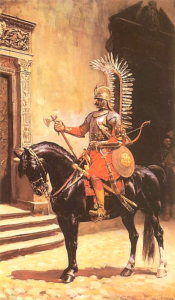10 July 1684 the Triumph at Szentendre
Prelude: the Battle at Vác
In 1684, the Emperor and King Leopold I, under the patronage of Pope Innocent XI, formed an alliance with the Republic of Venice and Poland under the leadership of John Sobieski. The main goal of the Holy League, as the treaty was called, was to repel the Turks. Leopold undertook to liberate the Hungarian territories, and his army was joined en masse by volunteers of German, English, Scottish, Italian, and other nationalities.

Emperor Leopold I of the Holy Roman Empire and King of Hungary and Bohemia appointed Charles V, Duke of Lorraine, the “silent prince”, (Lotharingiai Károly) to lead the allied Christian forces. During the late spring of 1684, the Duke set out with his army of 40,000. He set up camp at Vágsellye, and at the end of May, he marched towards the Hungarian capital. Between 15 and 18 June his army besieged Visegrád, which was finally abandoned by its Ottoman defenders.
The Duke defeated the army of Pasha Mustafa of Aleppo at Vác, on 27 June
In the meantime, the Mustafa Pasha of Aleppo arrived in Buda with his 15,000-strong army, forcing Prince Charles to change his plans. He did not attack Buda directly but wanted to invade Pest first. He turned back from Visegrád and crossed the Danube at Esztergom. Here he reinforced his army with the troops of Polish, Silesian, and Hungarian noblemen, and then marched along the Danube towards Pest. It was intended to give the impression that they were going against Nógrád, but Mustafa realized the intention and with 18,000 troops he rushed after the enemy.

The Ottoman army was positioned northwest of Vác, between the river and the Cigány (Gypsy) Hill, with a swamp in front of them increasing their advantage. Charles’s troops also formed a line of battle as they emerged from the Verőce Pass. The prince ordered the right flank and the center to attack from the front, while the left wing was to flank the Turks. He hoped to push the enemy into the Danube.

The battle of St. László’s Day was always initiated by the Imperials. As ordered, the right wing and the center attacked with vigor and managed to cross the marsh. They were already on the flanks of the opposing heights when the Turkish artillery came into action but to no avail. The high-flying shells did little damage to the Imperials. They, in turn, made their way up the high ground and pushed back the Turks, whose embarrassment was increased when a well-fired shot brought down the belligerent Pasha of Temesvár, Shedi (Szejdi) Ahmed.
The battle lasted for two hours, and the Turks finally gave up the fight due to the left flank attack. Schulz pursued the Ottoman cavalry with the dragoons. Some 1,200 Turks took the fortress walls, but the Imperial infantry and artillery soon laid siege to the fortress. At 9 p.m., the defenders asked for a treaty and were met with more heavy cannon fire, finally opening the gates at 11 p.m. It was how the Duke also took the castle of Vác. It was a crushing victory, mainly because of the better artillery and firearms of the Imperials. The Duke lost only 20-60 men while the Ottomans 3,000 soldiers and the Hungarian Hussars cut down 700 of them.

The struggle at Pest
After this fight, the Imperials rested for two days, then they set out toward Pest on the left bank of the Danube river on 29 June. The enemy gave up the town of Pest quickly but before withdrawing, they slaughtered every Christian inhabitant. They also burned the bridge behind themselves to prevent the Imperial army from crossing the river to the Buda side. You can read more about the town of Pest here:
https://www.hungarianottomanwars.com/ottoman-occupied-lands/pest/

Duke Charles and Rüdiger Starhemberg did not take the risk of assaulting Buda from the direction of Pest because they did not have enough soldiers. Finally, they took the advice of Louis of Baden. He suggested reinforcing Pest, then crossing the Danube a bit to the north, around Szentendre. They left 1,400 infantrymen and 300 cavalrymen in Pest and set out toward Vác where they could cross the river through a boat bridge. The crossing was successfully carried out on 8-10 July. Then, the whole army began marching toward Buda from the north.

The Battle of Szentendre
Again, Pasha Mustapha of Aleppo attempted to hinder the Christian army’s way to Buda. He set out against them with 20,000 soldiers, 800 Janissaries, and two cannons. By the time they arrived at Szentendre, the Christian army had been waiting for them in battle order. The Imperials were deployed behind a marshland that was defending them. The left wing of the Duke stood next to the Danube while his right wing took up positions on higher ground above the town of Szentendre.

Pasha Mustapha thought that he had faced only the vanguard so it was the reason why he ordered the launching of an attack. He planned to surround the Christians from the left side but his troops ran into the two Dragoon regiments of General Caprara. They managed to block the Ottomans and even began to attack the enemy. You can read more about Dragoons on the Hungarian battlefields here:
https://www.hungarianottomanwars.com/essays/dragoons-in-hungary/

At the same time, the entire Christian army came into motion. Duke Charles advanced far ahead of his men and he was in serious peril of getting killed. Finally, the Imperials seized the victory but the Ottomans remained on the battlefield all day long. They left for Buda only at night. The Ottoman army made camp south of Buda at Érd, at a place called Hamzsabég. As we can see, the fighting morale of Mustapha’s army was still unbroken despite the two defeats that they had suffered at Vác and Szentendre. At Hamzsabég, they were waiting for the call of Pasha Kara Mehmed and Sejtán Ibrahim of Buda in case they were needed in the castle.

The Christian army began the siege of Buda on 14 July 1684. However, the systematic siege was being hindered by the Serdar’s army that was at Érd (not too far from Buda), under the command of Pasha Mustapha of Aleppo. Thus, Duke Charles decided to eliminate this threat. He set out on the dawn of 22 July 1684, leading 30,000 German and Hungarian cavalrymen. His goal was to scatter the Serdar’s approximately 20,000 Ottoman cavalrymen. He succeeded in beating them for the third time but Buda could not fall just yet. They had to wait two more years for that.
You can read about the third victory that Duke Charles of Lorraine achieved at Érd here:
https://www.hungarianottomanwars.com/1541-1699/the-turk-reinforcement-was-defeated-at-erd-1684/
Source: Szibler Gábor
Dear Readers, I can only make this content available through small donations or by selling my books or T-shirts.
If you like my writings, please feel free to support me with a coffee here:
You can check out my books on Amazon or Draft2Digital, they are available in hardcover, paperback, or ebook:
https://www.amazon.com/dp/198020490X
or at https://books2read.com/b/boYd81


My work can also be followed and supported on Patreon: Become a Patron!http://Become a Patron!


https://hungarianottomanwars.myspreadshop.com/

https://hungarianottomanwars.myspreadshop.com/all


